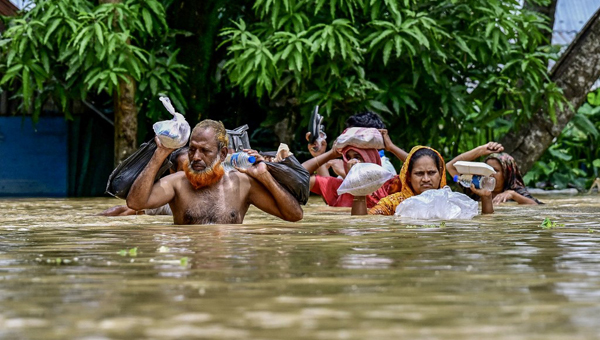News Desk : dhakamirror.com
The worst-affected people received the least relief assistance in the flash flooding that swept parts of Bangladesh in August affecting over 5.6 million people, revealed a Centre for Policy Dialogue analysis.
The analysis, released on Sunday, estimates the overall loss and damage suffered by 11 districts in the flood at minimum Tk. 14,421.46 crore or around $ 1.20 billion.
Noakhali, the worst-hit district in the flood, received Tk 14.9 crore in relief for over 1.6 million people, the analysis said, with a per head relief allocation of Tk 92.9, the second lowest allocation of relief.
Noakhali made up for 29.07 per cent of the total damage, followed by Cumilla with 23.51 per cent, Feni with 18.61 per cent and Chattogram with 11.63 per cent.
Lakshmipur received the lowest per capita relief allocation of Tk 62.1 as the district received Tk 3.3 crore in relief assistance for its over five lakh affected people, the analysis shows.
Lakshmipur was the fifth worst-affected district in terms of monetary valuation of the damage.
The per capita relief allocation for the affected population in Cumilla was Tk 136.7 where Tk 14.9 crore was distributed in relief assistance to over 10 lakh people.
Ten lakh people were affected by the flooding in Feni which received Tk 16.6 crore in relief assistance, the analysis said, with Tk 165.8 per capita relief allocation.
Sylhet which had less than 10,000 people affected in the flooding received Tk 14.6 crore, almost the same as received by the worst-affected areas, including Noakhali and Cumilla. The per capita relief allocation in Sylhet stood at Tk 15,320.4.
Habiganj with an affected population of 20,840 received Tk 13.4 crore with a per capita relief allocation of Tk 6,450.
The 11 districts included in the analysis are Sylhet, Moulvibazar, Habiganj, Feni, Khagrachhari, Coxsbazar, Cumilla, Noakhali, Chattogram, Lakshmipur, and Brahmanbaria.
Among the six broad sectors considered for the damage assessment, the analysis said, agriculture and forestry sector suffered the worst with damage estimated at Tk. 5169.71 crore—which is 35.85 per cent of the total damage.
Infrastructure sector stands second in terms of damage worth Tk. 4653.92 crore accounting for 32.27 per cent of the total damage, followed by the housing sector with Tk. 2407.31 crore, accounting for 16.69 per cent of the total damage.
Considering sub-sectors, the analysis said, roads suffered the biggest damage, accounting for 28.68 per cent of the total damage, followed by crops accounting for 21 per cent damage, housing 16.69 per cent, water and sanitation facilities 14.2 per cent, and fisheries 10.9 per cent.
Livestock accounted for 2.11 per cent of the total damage, followed by bridges and culverts accounting for 1.96 per cent damage, poultry sector 1.79 per cent, embankments 1.09 per cent, education 0.62 per cent, industry 0.26 per cent, railway 0.23 per cent, electricity lines 0.17 per cent, religious structures 0.13 per cent, healthcare centres 0.10 per cent, forests 0.06 per cent, and mobile towers 0. 001 per cent, the analysis showed.
The flash flood was triggered by cloudbursts over a vast landscape covering 50–70km from Tripura in India to Cumilla and Feni on August 19.
Until August 22, heavy rainfall was recorded in both Bangladesh and India with 435mm of rainfall recorded in Feni, 557mm in Cumilla and 605mm in Noakhali.
The impact of the flooding was compounded after India opened gates at the Dumbur dam in Tripura on August 21.
The runoff carried so much water that it lifted the Gumti River 113cm above its danger level, breaking a 27-year record, the analysis said. Flood protection embankment along the Gumti collapsed, leading to a prolonged waterlogging that is still present in some areas.
At least 54 people were killed in the flooding until August 30.
Following the analysis, the CPD came up with a number of recommendations, which included relief budget allocation, extending social safety net coverage for elderly people, widows and destitute women, ensuring loan for farmers, and improving emergency response system by arranging sufficient boats in areas vulnerable to flash flooding.
The flash flooding in August came on the heels of a series of natural disasters.
In June, heavy rain triggered flood affecting hundreds of thousands in Sylhet, Dhaka, Mymensingh, Rangpur and Chattogram divisions.
Nearly 46 lakh people across eight costal districts were affected by the cyclonic storm Remal that hit the coastal region end of May. The loss and damage caused by the storm was estimated to be $600 million. The affected districts included Satkhira, Khulna, Bagerhat, Barguna, Patuakhali, Barishal and Bhola.





















